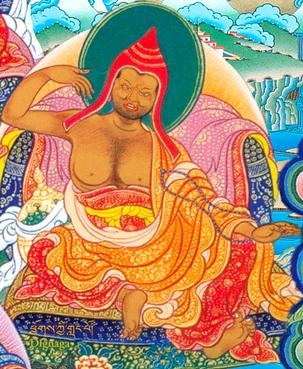Dignaga: Difference between revisions
mNo edit summary |
mNo edit summary |
||
| (7 intermediate revisions by 4 users not shown) | |||
| Line 1: | Line 1: | ||
[[Image:Dignaga.JPG|frame|'''Acharya Dignāga''']] | [[Image:Dignaga.JPG|frame|'''Acharya Dignāga''']] | ||
'''Dignaga''' (Skt. ''Dignāga''; | '''Dignaga''' (Skt. ''Dignāga''; Tib. [[ཕྱོགས་ཀྱི་གླང་པོ་]], ''chok kyi langpo'', [[Wyl.]] ''phyogs kyi glang po'') (circa 6th century AD) was one of the six great commentators (the ‘[[Six Ornaments]]’) on the Buddha’s teachings. He was one of the four great disciples of [[Vasubandhu]] who each surpassed their teacher in a particular field. Dignaga was more learned than Vasubandhu in [[pramana]]. His reputation as unequalled in [[debate]] was cemented through his celebrated victory over the brahmin named Sudurjaya at [[Nalanda|Nalanda monastery]]. | ||
Among his disciples was | Among his disciples was Ishvarasena, who later became the teacher of [[Dharmakirti]]. | ||
==Writings== | ==Writings== | ||
His early (extant) works were: | His early (extant) works were: | ||
* The Abhidharmakośa- | * The [[Abhidharmakosa Vrtti Marmadipa|Abhidharmakośa-vṛtti-marmapradīpa]] - a condensed summary of [[Vasubandhu]]'s seminal work | ||
* A brief summary of the Aṣṭasāhasrika-prajñāpāramitā sūtra | * A brief summary of the Aṣṭasāhasrika-prajñāpāramitā sūtra | ||
| Line 14: | Line 14: | ||
* Hetu-cakra-samarthana | * Hetu-cakra-samarthana | ||
* Nyāyamukha | * Nyāyamukha | ||
* [[Pramāṇa-samuccaya | * [[Compendium of Valid Cognition]] (''Pramāṇa-samuccaya''), which was a condensation of all these works | ||
Also a commentary on Vasubandhu's ''Ekagāthābhāṣya'', the ''Ekagāthābhāṣya-ṭīkā'', is attributed to him. | |||
==Further Reading== | ==Further Reading== | ||
*Hattori, Masaaki. ''Dignāga, On Perception''. Cambridge, Harvard University Press, 1968. | *Hattori, Masaaki. ''Dignāga, On Perception''. Cambridge, Harvard University Press, 1968. | ||
*Hayes, Richard P. ''Dignāga on the Interpretation of Signs''. Dordrecht, Netherlands: Kluwer, 1988. | *Hayes, Richard P. ''Dignāga on the Interpretation of Signs''. Dordrecht, Netherlands: Kluwer, 1988. | ||
*Douglas Duckworth, Malcolm David Eckel, Jay L. Garfield, John Powers, Yeshes Thabkhas, Sonam Thakchoe, ''Dignaga's Investigation of the Percept: A Philosophical Legacy in India and Tibet'', Oxford University Press, 2016, ISBN 978-0190623708 | |||
==External Links== | |||
*{{TBRC|P6126|TBRC Profile}} | |||
[[Category: Historical Masters]] | [[Category: Historical Masters]] | ||
[[Category:Indian Masters]] | [[Category:Indian Masters]] | ||
[[Category: Seventeen Nalanda Masters]] | [[Category: Seventeen Nalanda Masters]] | ||
Latest revision as of 22:57, 3 July 2022

Dignaga (Skt. Dignāga; Tib. ཕྱོགས་ཀྱི་གླང་པོ་, chok kyi langpo, Wyl. phyogs kyi glang po) (circa 6th century AD) was one of the six great commentators (the ‘Six Ornaments’) on the Buddha’s teachings. He was one of the four great disciples of Vasubandhu who each surpassed their teacher in a particular field. Dignaga was more learned than Vasubandhu in pramana. His reputation as unequalled in debate was cemented through his celebrated victory over the brahmin named Sudurjaya at Nalanda monastery.
Among his disciples was Ishvarasena, who later became the teacher of Dharmakirti.
Writings
His early (extant) works were:
- The Abhidharmakośa-vṛtti-marmapradīpa - a condensed summary of Vasubandhu's seminal work
- A brief summary of the Aṣṭasāhasrika-prajñāpāramitā sūtra
His remaining works were all pertaining to logic:
- Ālambana-parīkṣā
- Trikāla-parikṣa
- Hetu-cakra-samarthana
- Nyāyamukha
- Compendium of Valid Cognition (Pramāṇa-samuccaya), which was a condensation of all these works
Also a commentary on Vasubandhu's Ekagāthābhāṣya, the Ekagāthābhāṣya-ṭīkā, is attributed to him.
Further Reading
- Hattori, Masaaki. Dignāga, On Perception. Cambridge, Harvard University Press, 1968.
- Hayes, Richard P. Dignāga on the Interpretation of Signs. Dordrecht, Netherlands: Kluwer, 1988.
- Douglas Duckworth, Malcolm David Eckel, Jay L. Garfield, John Powers, Yeshes Thabkhas, Sonam Thakchoe, Dignaga's Investigation of the Percept: A Philosophical Legacy in India and Tibet, Oxford University Press, 2016, ISBN 978-0190623708